Veteran’s Testimony – F. Evangeline Blauvelt 136th Station Hospital

Colored portrait of 1st Lieutenant F. Evangeline Blauvelt, ANC, N-751717.
Introduction & Enlistment:
My name is Florence Evangeline Blauvelt, known now as “Vangie” Hooker. I was born on 10 May 1921 in Yarmouth, Nova Scotia, Canada. When I was a year old my parents moved to the United States and Medford, Massachusetts, to be near my grandmother and her parents. I went all through school there and graduated from Medford High School in June 1939. In September, I entered the New England Baptist School of Nursing, and graduated in September 1942. After passing State Boards, and working for a few months, four of my classmate friends and I decided to join the Army Nurse Corps. There was Erma L. Whittier, Lorraine L. Clifford, Etta J. Cooper, Ruby “Betty” E. Rose, and I. At the Recruiting Office in Boston, we had physicals, and were given orders to report to Fort Devens, at Ayer, Massachusetts (Military Reservation –ed). On 19 April 1943, we were now Second Lieutenants and my Army Serial Number was N751717.
Without Basic Training (being a RN), I became a General Duty Nurse (MOS 3449) and worked on a ward, taking care of soldiers who had returned from the Pacific Theater, with malaria, and other maladies. I don’t remember much about our stay at Fort Devens, except that the food was excellent, and we were instructed to have all we wanted but had to eat everything on our plates. There was an Officer monitoring this, and to this day I don’t put anything on my plate that might be left over. I guess old habits never die.
In June there was a note on the dining room bulletin board asking for volunteers to join a Hospital that was forming for service overseas. After some discussion, we all signed up, as the five of us wanted to stay together as long as we could.
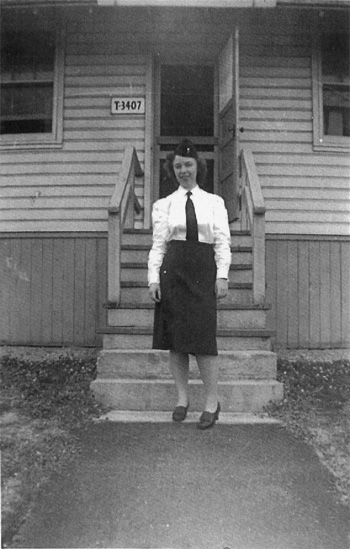
Picture of 2d Lieutenant Evangeline Blauvelt taken while at Fort Devens, Massachusetts, April 1943 (still wearing the old d. blue uniform).
(in July 1940 Ft. Devens, Ayer, Massachusetts, became the Reception Center for New England recruits, who would serve 1 year as a draftee with the US Army. Between 1940 – 1946, the Center processed 614,021 men. After expanding, over 65,000 troops were stationed at the Reception Center from August to September 1941. In April 1943, Ft. Devens became Headquarters to the 4th WAAC Training Center. In July 1943, civilian Nurses also received Basic Training at Ft. Devens, an innovation from prior practice, and after graduation, they were immediately sent into Army Hospitals for practice and on-the-job-training. The first class of 27 Enlisted Nurses graduated in August, with the output steadily increasing to 100 Nurses/month in order to meet New England’s quota of 800 that could serve overseas. In addition, Ft. Devens later became the site of a New England Training Center for student Cadet Nurses in April 1944. Between 1944 and 1945, Ft. Devens housed many training programs, and the ASFTC’s 3 Training Regiments and 19 Training Schools made it one of the largest and busiest Training Centers in the eastern United States –ed).
In late June, without being told anything; where we would be sent, when we would eventually travel, we subsequently were given orders to report to Camp Edwards (Antiaircraft Artillery Training Center –ed) on Cape Cod. Once there, we joined the 750-bed 136th Station Hospital (activated at Cp. Barkeley, Abilene, Texas, 15 August 1942), in need of additional ANC personnel, which was being formed to go overseas. The Hospital’s first group of Nurses had arrived on 27 May, but they were looking for more personnel to reach the authorized T/O strength. (T/O 8-560, dated 22 July 1942, provided 75 Nurses). Our Basic Training consisted of going through the gas chamber facility, and learning that our gas masks were to be taken with us always, a little marching, how to tackle the obstacle course, and finally taking the infiltration course. At that time, we got acquainted with those we were to spend the rest of the war with. While there, the Army decided that I should become a U.S. citizen. They said that after the war I might have trouble getting back into the United States… so on 19 July 1943, two Officers took me to court in Boston, gave testimony that I was a good person and I was sworn in by the judge to be a citizen of the United States.
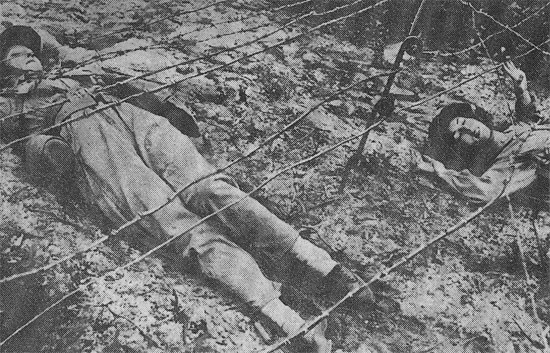
Picture taken in Camp Edwards in June 1943. Nurses 2d Lieutenant Aileen E. Akins (N-720676) and 2d Lieutenant Harriette E. MacKeeken (N-751749), of the 136th Station Hospital, squirm under barbed wire during the infiltration course at Camp Edwards, Massachusetts. This picture was taken before the unit went overseas.
Preparation for Overseas Movement:
When we were all ready, we received marching orders to go to Camp Shanks, in Orangeburg, New York (Staging Area for the New York Port of Embarkation –ed). The unit entrained on 21 July 1943 for its new destination. We were however not told our destination. While we were there, we received the necessary instructions, including lessons about security, the articles of war, power of attorney and last will documents, change of address forms, sex life and V.D., how to abandon ship, Geneva Convention ID documents; followed by inoculation shots, gas warfare drills and did a lot of marching. Toward the end of our stay there, we were given some short passes, and we went into New York. One weekend Erma and I forged a pass and took the bus into N.Y. Central Station, called our folks in nearby Boston, and took the train to go and visit them. I am a rule follower, and that was out of my comfort zone, but we just HAD to see our folks one more time before leaving. When we came back to New York Sunday night, someone at the bus station told us that our unit had left! In fear and trembling we went back to camp and found no one had missed us, as not a word was ever said about our short escapade.
At the time our uniforms still consisted of blue skirts, white shirtwaists, black neckties, blue garrison caps, and black shoes. But once at Camp Shanks, everything suddenly changed to olive-drab, including the blue cape. As a matter of fact we were lucky, although the change from blue to olive-drab had already been authorized 5 September 1942, some Nurses going overseas were still issued blue uniforms. Consequently, the blue uniform (dating from 1940 –ed) continued to be considered as a real dress uniform until the end of WW2.
Departure finally took place on 20 August 1943 with the RMS “Queen Elizabeth” (Royal Mail Steamship, converted into a troop ship, which served as an American troopship carrying over 750,000 troops between 1942-1945 –ed) reaching the Firth of Clyde 27 August. The ship wasn’t only transporting personnel for the 136th Station Hospital, on board were the 67th Fighter Wing too (activated 15 Jun 43, assigned to the 8th USAF, stationed at Bedford Army Air Base, Massachusetts, until 4 Aug 43, and based at AAF-372, Wallcott Hall, United Kingdom, 26 Aug 43 –ed). The ex-liner sailed alone and not in a convoy as she could reach an average speed of 26 knots. Her troop capacity was approximately 15,000. We were finally told aboard ship by a British crew member that we were bound for England!
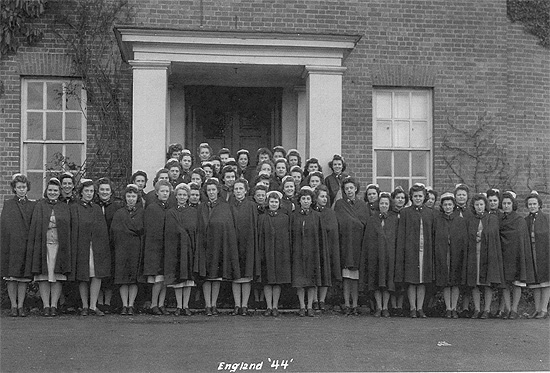
Nurses’ Staff 136th Station Hospital, picture taken in front of the Estate house. Captain Helen M. Thomae (N-701793) Principal Chief Nurse is twelfth from right (tall lady with crossed arms under her cape), 1st Lieutenant F. Evangeline Blauvelt (N-751717) is sixth from left.
United Kingdom:
Our ship landed in Scotland on 27 August 1943, and after disembarking in the evening, we assembled, received some “meat pie” from a group of local ladies, and boarded a blacked-out train to our next destination. We traveled all night and arrived at Sudbury, County of Suffolk, England, in the morning. Upon arrival, the necessary trucks awaited and took us to the place where the Hospital was set up, waiting for us to get ready for patients.
The 136th Station Hospital was situated only three miles from Sudbury, one and a quarter miles from Long Melford, approximately twelve miles from Bury St. Edmunds, and eighteen miles from Ipswich. The site was located at Acton Place (which held a beautiful Manor) on an old estate, with some brick buildings. The medical installations were situated on the outskirts of the village of Acton on the Acton-Long Melford road. Although satisfactory quarters (buildings and huts) were available on arrival, there was still a lot to do. The reserved area was occupied by the British contractor who was still busy completing the camp’s construction. When we got to the Hospital itself we had to get it ready for patients, but were promised some free time for ourselves too, after we had made up all the beds, and got everything ready. Between arrival and official opening of the installations all personnel was involved in preparation of the buildings, the distribution of equipment and supplies, and in training for full operation. Our bed capacity was 834, with an expansion potential up to 1,254. Official opening for reception of patients took place on 14 September 1943. The 136th Station Hospital (activated 15 August 1942 –ed) was normally normally engaged in routine surgery and care of battle casualties received by Hospital Trains and evacuated from the continent after D-Day. However, it was in fact specifically set up to treat sick and injured personnel from a number of USAAF airfields situated in the region.
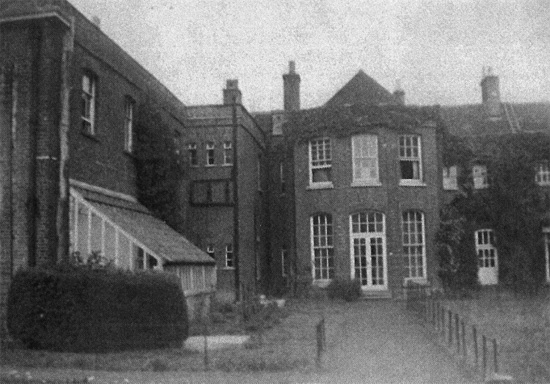
Picture illustrating the “Big House”, where the 136th Station Hospital Chief Nurse (Captain H. Thomae) lived …
USAAF Units stationed in and around Sudbury
(some of the units in Suffolk, there were quite a few more)
Ridgewell (south of Sudbury) Station AAF – 167 (381st Bomb Group)
Lavenham (northwest of Sudbury) Station AAF – 137 (487th Bomb Group)
Debach (northeast of Sudbury) Station AAF – 152 (493d Bomb Group)
The Hospital’s initial Commanding Officer whom I knew was Colonel Joseph D. Stout, MC, an older doctor who took command 12 October 1942, later suffered a cerebral hemorrhage and died from natural causes 6 November 1944. He was temporarily replaced by Lt. Colonel Augustus H. Lancaster, MC, who remained in command until 5 December 1944 (assigned to the 136th Station 29 October 1943 –ed). Colonel George E. Lindow, MC, was then assigned to the 136th Station Hospital and assumed command of the organization 5 December 1944. The Principal Chief Nurse, Captain Helen M. Thomae, ANC, (who had joined the unit 27 May 1943), had her rooms in the brick house, along with some of the ANC personnel. It wasn’t really much to be envious of. In the back of the house were a row of 5 or 6 Nissen huts that each housed 8 Nurses. Accommodation was rather basic, with 8 folding cots, and a single pot-bellied stove in the center. Our bathroom was located in another hut which contained four basins, one bathtub, and several showers. I must say that it became pretty crowded sometimes and the water wasn’t always hot. We were assigned a GI who brought us coal, kept the latrine clean, etc. When off duty, he also taught me to ride a bicycle which was hilarious. In the hut that we shared, Hut 83, were some of the girls I enlisted with: 2d Lieutenant Dinah M. Selvin (M-530), the Hospital’s Physical Therapist, and 2 others, 2d Lieutenants Stella Warchol (N-751822) and Ruth M. Sawyer (N-751912), from Connecticut. Dinah had the cot next to me and became a lifelong friend. We used sheets from the Hospital and put our sleeping bags under our mattress with a few clothes that weren’t being used.
Our huts were separated from the wards by a pathway and an old apple orchard, a rose garden, and in spring a field of daffodils under the trees. I shall never forget those bright yellow flowers as they gave us hope to an end to the war. We sometimes took flowers to the ward to brighten the soldiers’ surroundings. Along the estate’s outer boundary, were the other Nissen Huts with room for 30 patients in the ward, two private rooms, an office for the 2 Nurses and the Medical Officer assigned there. There was a latrine for the patients and a kitchen. In the middle of the ward was a big stove, which was kept going by the EM who kept the place clean, the coffee pot on, and helped with the patients if needed. The wards were all given a radio, and it was on most of the time with music, and the latest news.
136th Station Hospital – Major Staff (end 1944)
Colonel Joseph D. Stout, MC, O-215631 (CO until his death 6 Nov 44)
Lt. Colonel Augustus H. Lancaster, MC, O-486636 (Actg CO 6 Nov 44)
Colonel George E. Lindow, MC, O-10845 (new CO as from 5 Dec 44)
Lt. Colonel Walter R. Limbaugh, MC, O-131457 (new CO as from 5 Aug 45)
Lt. Colonel Jay F. Havice, MC, O-486872 (XO)
Captain George Staruch, Jr., MAC, O-1533204 (XO as from 30 Jun 45)
Captain Clarence E. McKeown, MAC, O-1541511 (new XO as from 31 Aug 45)
Captain Helen M. Thomae, ANC, N-701793 (Prin C/Nurse)
1st Lieutenant Katherine C. Bublitz, ANC, N-751288 (Asst C/Nurse)
Captain Martin J. O’Donnell, ChC, O-499055 (Cath Chaplain)
Captain Gregor W. I. Kutz, ChC, O-525789 (Prot Chaplain as from 21 Feb 44)
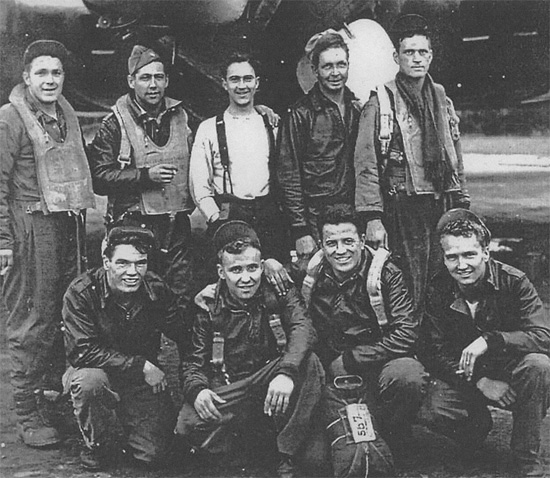
8th United States Army Air Forces crew members of the 486th Bomb Group (H) which occupied the nearby airfield, Chilton Station, AAF-174.
On one side of the Hospital was a farm, and on the other one was a B-24 / B-17 bomber base. Back of it was a wooded area, where the VD and the Psychiatric wards were situated, up there away from the rest of the installation. I was told one time that we were in the middle of about 16 airfields in the region. Our organization was the main Hospital dedicated to deal with USAAF units in the area and provided the necessary medical support to the 486th Bomb Group (H) which occupied the nearby airfield (designated Chilton Station, AAF – 174 –ed). After we were ready for operation, we started receiving quite a few patients from this Army Air Force Base (the Group consisted of the 832d, 833d, 834th, 835th Bomber Squadrons, part of 3d Air Division, Eighth United States Army Air Force –ed), and we were kept pretty busy. Our cases often consisted of severely injured aircrews which had either crashed or been shot at by the enemy during a mission, or had become victims of mid-air collisions, resulting in severe burns. Sick and injured personnel also came in, suffering from common injuries, infections, pneumonia, etc. They were sometimes brought by the Station’s own ambulances. I worked on ward 23 with 2d Lieutenant Stasia E. Klenk (N-751848), and Captain Saul H. Sherman, MC, (O-435588) from Connecticut. The 63 Nurses usually worked 12-hour shifts.
486th Bomb Group, Heavy, AAF Station – 174
Arrival at Sudbury, Suffolk, March 1944
Started operations with B-24 Liberators, 7 May 1944
Re-equipped with B-17 Flying Fortresses, 1 August 1944
Last mission over Germany, 21 April 1945
Life in England:
My first Christmas in England was a very nice one, notwithstanding our distance away from the United States. We had loads of packages. Each ward was allocated a new radio, so we could listen to American programs all day, and I can tell you that it did some good. Receiving packages and letters from home helped us keep up morale. Christmas Dinner really was the cure to some of our homesickness as we had turkey with all the necessary trimmings. The dining room had been decorated with white tablecloths, place cards, flowers, candles, and we even had a genuine Christmas tree! It was really lovely, and I’ll never forget it. On Christmas Day, many of us went to our chapel on the base and sang carols, which of course made a lot of us even more homesick.
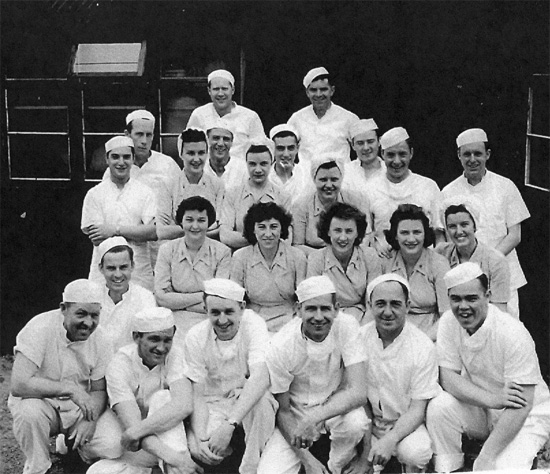
Picture illustrating the staff of the Operating Room, 136th Station Hospital, 1944, England.
When we had some time off, we walked around and often ventured into Sudbury (where AAF – 174 was situated –ed) on foot. The local people were very interested to see American women, who had stockings! Some locals were reluctant to make our acquaintance, but I must say that the majority were welcoming. Several of us met a couple, Mr. and Mrs. Bishop (don’t remember the circumstances) who owned a pub called the “Rising Sun”, situated in Plough Lane. None of us girls were drinkers, but these people welcomed us to their private home, attached to the pub, and we fast became friends all the time we were there. This particular couple had no children, so they practically made us theirs! Being away from home, yet welcomed by friendly locals, and even sometimes sleeping at their place, was near heaven. Imagine the comfort of a real bed. It became a habit to take any food we could get to those friendly people.
I visited London, saw the old buildings, the Royal Palace, London Bridge, and many of the bombed areas and it was awful. The City was making an enormous effort to clear the debris and try to rebuild it all again. Among girls we also took the train to Cambridge which became a favorite day off place. When passes became more frequently available and we were off duty, we went to dances, musicals, and shows, and I must say that getting into town and more civilized places once in a while was nice, although you needed plenty of money. While on leave in Scotland, I discovered such beautiful scenery, moreover the Hotel I stayed at was nice, with a comfortable room, and I really felt more human for a change. There were of course plenty of men around who wouldn’t leave us alone, so we went to dances and parties. I remember that it seemed so funny to see men wearing kilts at the time.
Getting used to the English climate proved hard to deal with and remained difficult even in summer. We finally managed to get fairly warm in Hut 83, as we kept up a continuous fire going, even at night, and certainly during winter. I was very happy to receive a hot water bottle sent by some relatives, as it came in quite handy. The climate was always damp and cold, and we often had to wear sweaters to keep warm.
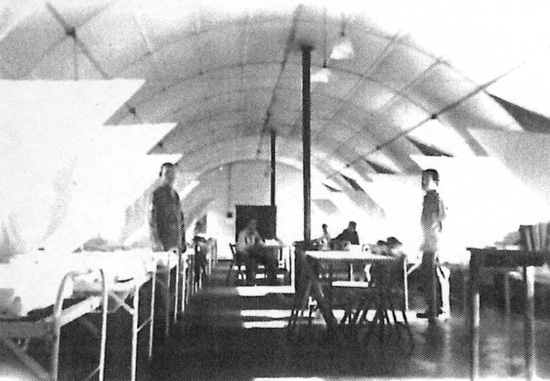
Partial view of Ward # 23, where Nurse Evangeline Blauvelt worked.
Many of us bought or hired bicycles to ride in the country. In summer we often went for rides, watching the B-17s Fortresses take off and land, pick up flowers in the fields, and have some fun, trying to enjoy life. There were a few courtships going on during those two years no one talked about, especially since some of them involved Officers and Enlisted personnel which was a “nono” at the time! Every time I saw a couple looking happy, I got mad at Hitler, to think that he was keeping all ‘that’ away from me! No one really had time for dates unless it was someone on the Post, and many of the men were either married or ‘wolves’.
Some of my duty hours involved 3 weeks of night duty as all of us did for three weeks at a time (12-hour shifts were the norm). When I was off duty I had about 4 hours a day of continuously interrupted sleep because of the many sounds around the installation, including the loud roar of aircraft engines. The food received was neither very good nor very bad. But whenever we had nothing special to talk about, we always planned meals! We even tried to accommodate corned beef with cabbage. I never thought we would eat cabbage and Brussels sprouts.
After the D-Day landings and the continuous bombing campaigns over Europe, we received more and more patients, which kept us quite busy. We heard many stories from the poor kids who had lived in muddy foxholes on K-Rations for a month, without comfort, cold, and miserable. The wounded we treated thought they now were kings because they had sheets on their beds and decent food for a change.
Only 9 night Nurses for about approximately 1,000 patients was too little – all of us of were dreading those long shifts – though on the other hand it felt good to be among the boys. Servicing the wards was not always fun; we often had very serious conversations with some of the patients, discussing homesickness, marital problems, amoral consequences, and some of us did receive letters of thanks for those ‘special’ times. Of course there were some sexual harassment episodes from Officers which I tried to ignore as much as possible. I recall some of the incidents too, as the one when we were told that a General would come and inspect the unit. We thus had to ‘spit and polish’ everything, including the patients. The General Officer came earlier than expected while I was giving a patient a bed bath in a private room – we were supposed to get up and stand at attention, patients at the foot of the bed if able. I hadn’t finished shaving the boy when the General came in. I got up and quickly saluted him without putting the razor aside. He had a hard time keeping a straight face and instructed me to salute him again without the razor, which I did. The story got around, and after that whenever I came in the front door of the ward, the patients shouted ‘attention’ stood up and saluted me. They thought it was hilarious, as did I.
In June of 1944, the boy I left in the U.S. when moving overseas sent me a “dear John” letter saying he was getting married! That was while I was in hospital with pneumonia the first time, but it wasn’t that bad after all, as I was about to tell him that he was not “the one” anyhow.
July 1944; it started getting monotonous wearing those wool uniforms and our feet, though comfortable, ached for a pair of “heels”. The hats we were wearing, 5-years old, were neither dry-cleaned nor pressed, and without stockings (hard to get), we simply were dying to see an American woman in civvies. Some of us did receive some toiletries or articles of clothing from home, but we once and then would have liked to dress as real women nevertheless.
By end August 1944, late summer, everybody was so happy to learn about the Liberation of Paris, France, and some of the Free French in London threw some parties that we will not forget. Betting was going on about the end of Nazi Germany now…The 1944-1945 winter was particularly severe in Sudbury, and I remember the 486th Bomb Group aircraft being grounded by snow and ice for a number of days.
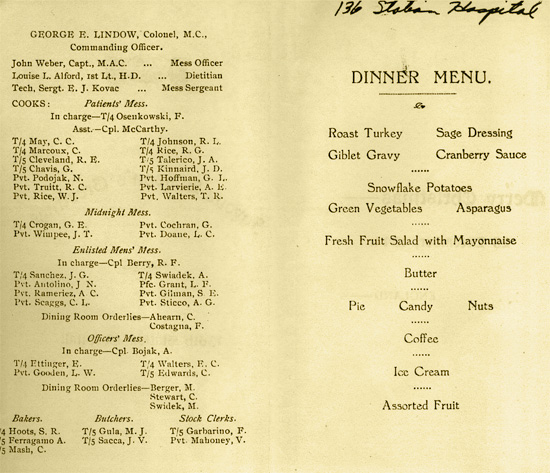
Copy of the 1944 Christmas Dinner Menu (25 December 1944), prepared by the 136th Station Hospital for its members.
During January 1945, we received quite a number of soldiers from the Belgian Ardennes suffering frostbite and trench foot. They had been evacuated after the German breakthrough in December. The casualties were brought to Sudbury by Hospital Trains. Loads of young doughs were coming in at night, usually around 2100.
End 1944, early 1945, I got involved with an ex-patient whom I treated and pampered for about a month, and then it ‘happened’ – I met him in London 2 days after he had been discharged from the 136th Station Hospital, and eventually continued to meet him. He hailed from Los Angeles, was 25 years old, a widower of 2 ½ years, with the rank of Staff Sergeant. Although against Army Regulations (Officers weren’t supposed to get involved with Enlisted personnel –ed) we managed to coordinate our leaves and visited places, organized trips, and enjoyed dinners and shows. During a visit to London, with my best friend Erma and her boyfriend Ralph from Ohio, we had a wonderful time sightseeing and traveling. In March we all went to Scotland on a week’s leave, and that’s where Jim asked to marry me. I said yes, and he had his sister buy a diamond ring and send it to him. Jim gave me the ring, while in London, this was 4 May 1945.
Whenever I think of it, during winter (this must have been February 1945), we quietly hoped the weather would keep so our flyboys would continue to go bomb Hitler’s Germany. They now sounded like music to our ears, as we knew that when flying, it brought us one day nearer our heart’s desire – HOME! We still had 600 patients in the Hospital in March-April 1945.
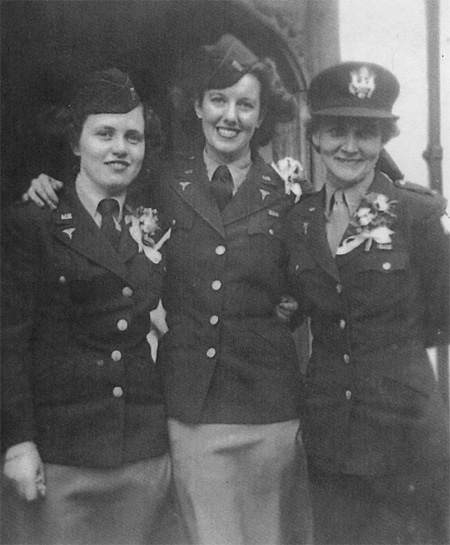
Picture taken at 2d Lieutenant Lorraine L. Clifford’s (N-751755) wedding ceremony in May 1945. Nurse Clifford stands in center, while 2d Lieutenant Erma L. Whittier (N-751701) is at the left (the name of the other Nurse at the right is unknown).
I thought that I got sick in May, shortly before before V-E Day, but it was probably in June, as that was the last time we spent our leave in London, and I returned to the Hospital and to a bed for the next 5 months. As from June 1945, rumors were circulating to let us return home. Some Nurses were being shipped out to other Hospitals, while we received new ones little by little, so, I was thinking that if I got transferred, I hoped it would be to a unit that was on its way to the ZI.
As the personnel were transferred I was evacuated to a General Hospital at Diss, in Norfolk. Jim was able to visit me, as he didn’t return to the States until December 1945, and meanwhile restrictions about dating or marrying lower ranks were no longer in force. I stayed at Diss until mid August, after which all of us patients were sent by Hospital Train (me on a stretcher), to Southampton. I returned to the Zone of Interior on a Hospital Ship, the USAHS Aleda E. Lutz (Master > Captain Norman Lovegrove; CO > Colonel Paul H. Leach, MC; medical complement; 18 Officers, 44 Nurses, 188 Enlisted Men –ed), the date was 20 August 1945.
The trip lasted 9 days and weathered a violent storm during which even the Merchant Marine crew were sick, and a mental patient jumped overboard but was saved. I’ll never forget the greetings we received coming into New York harbor, with sheets hanging out of the office buildings saying WELL DONE and WELCOME HOME, as well as small boats, tugs, etc. blowing their whistles, sirens, the lot.
After disembarking, I was taken to Halloran General Hospital, Willowbrook, on Staten Island, for a few days, and then sent by train to Lovell General Hospital, Ayers, Massachusetts. I remained there until May 1946 and then went to Fitzsimons General Hospital, Denver, Colorado for more tests, as they suspected I had TB (one of Fitzsimons’ specialties was Tuberculosis –ed). While awaiting the test results I begged for and obtained a month’s leave, and returned to California where Jim and I got married on 27 May 1946. After my marriage leave, I returned to Denver to discuss my medical situation, and the tests results were good. I was subsequently sent to Fort Sheridan, where I was discharged 5 November 1946.

Picture of 1st Lieutenant Frank Newell, one of the young Officer pilots of the 486th Bomb Group (H), taken at Station – 174.
Awards:
I received the following awards: American Theater Ribbon (American Campaign) – Europe-African- Middle East Campaign Ribbon (EAME) – Victory Medal (WWII Victory), and was entitled to wear 4 overseas bars (each stripe representing 6 months of service).
My ASR Score, dated 2 September 1945 was only 51 points, but I was released under RR1-1 Regulations, and because the war with Japan had just ended. I was away on terminal leave from 1 August 1946 until 5 November 1946, date on which I was officially and Honorably Discharged at Fort Sheridan, Illinois, Separation Center.
Our sincere thanks go to 1st Lieutenant F. Evangeline Blauvelt ANC (ASN:N-751717), who served as a Nurse with the 136th Station Hospital in the United Kingdom from August 1943 to August 1945. “Vangie” spontaneously offered to share her personal recollections with the MRC Staff, which helped us edit this concise Testimony.
